Choosing eco-friendly tours for family outings not only enhances the experience of exploring nature but also fosters a sense of environmental responsibility. In San Francisco, families can enjoy a variety of sustainable tour options that educate participants about local ecosystems while minimizing their ecological footprint. These tours create memorable bonding moments and instill important values of conservation in children, encouraging them to be mindful of their impact on the planet.
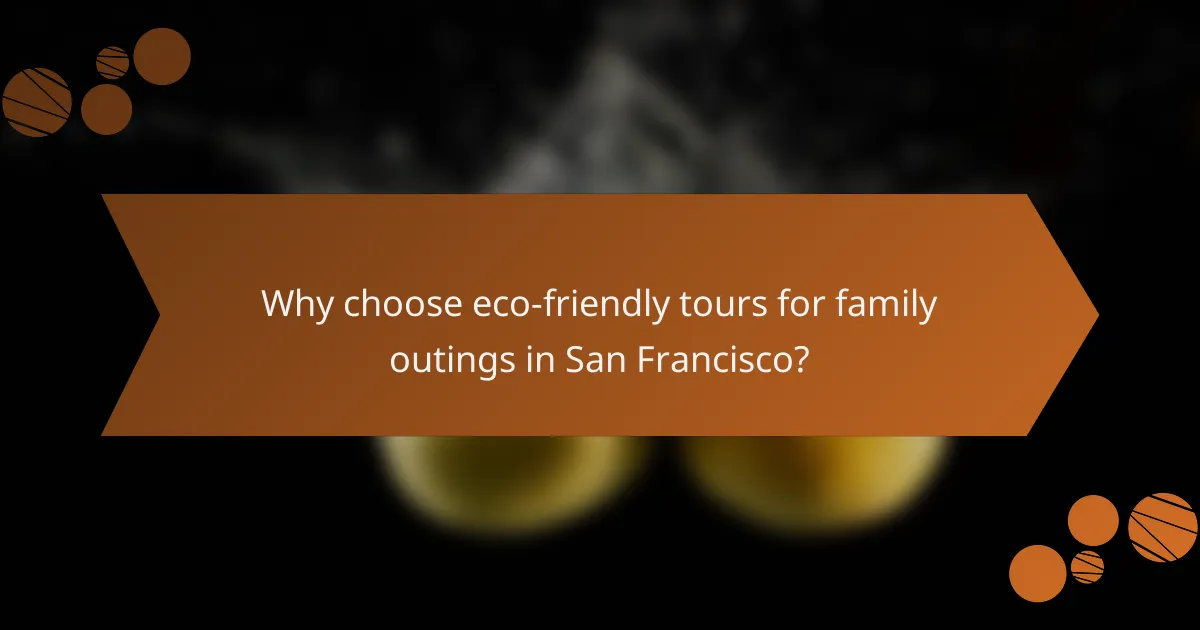
Why choose eco-friendly tours for family outings in San Francisco?
Choosing eco-friendly tours for family outings in San Francisco helps promote sustainability while providing enjoyable experiences. These tours focus on minimizing environmental impact and often include educational elements that engage families in conservation efforts.
Promotes environmental awareness
Eco-friendly tours are designed to educate families about local ecosystems and conservation practices. By participating in these activities, children and adults alike learn the importance of protecting natural habitats and reducing waste.
For example, guided nature walks often highlight native plants and wildlife, fostering a deeper appreciation for the environment. Families can also participate in activities like beach clean-ups, which provide hands-on experience in caring for their surroundings.
Supports local economies
Eco-friendly tours typically prioritize local businesses, which helps keep money within the community. When families choose these tours, they often support local guides, artisans, and restaurants that practice sustainable methods.
In San Francisco, this could mean dining at farm-to-table restaurants or purchasing handmade goods from local artisans. Such choices not only enhance the family outing but also contribute to the economic well-being of the area.
Enhances family bonding experiences
Participating in eco-friendly tours can strengthen family bonds through shared experiences and teamwork. Engaging in activities like hiking, kayaking, or wildlife watching encourages communication and collaboration among family members.
Moreover, the unique experiences offered by these tours create lasting memories. Families can enjoy the beauty of San Francisco’s natural landscapes while learning together, making the outing both fun and educational.

What eco-friendly tour options are available in San Francisco?
San Francisco offers a variety of eco-friendly tour options that cater to families looking to explore the city’s natural beauty while minimizing their environmental impact. These tours not only promote sustainability but also provide educational experiences about local ecosystems and wildlife.
Guided nature hikes
Guided nature hikes in San Francisco allow families to explore the diverse landscapes of the area, from coastal trails to forested parks. These hikes often focus on local flora and fauna, providing insights into the ecosystem and conservation efforts.
Consider joining a hike in places like the Golden Gate National Park or the Presidio, where knowledgeable guides lead groups through scenic routes. Look for tours that emphasize Leave No Trace principles to ensure a minimal impact on the environment.
Wildlife conservation tours
Wildlife conservation tours in San Francisco educate families about the importance of protecting local species and habitats. These tours often include visits to rehabilitation centers or nature reserves, where participants can learn about ongoing conservation projects.
For example, tours that focus on marine life might include a trip to the Marine Mammal Center, where families can observe rescued seals and sea lions. Engaging with conservationists during these tours can inspire a deeper appreciation for wildlife and the need for its protection.
Bicycle tours of the city
Bicycle tours are an eco-friendly way to explore San Francisco’s iconic sights while reducing carbon emissions. Families can rent bikes and join guided tours that take them through neighborhoods, parks, and along the waterfront.
Consider tours that include routes through Golden Gate Park or across the Golden Gate Bridge, allowing for both exercise and sightseeing. Always check that the tour operator follows sustainable practices, such as using electric bikes or promoting safe riding habits.
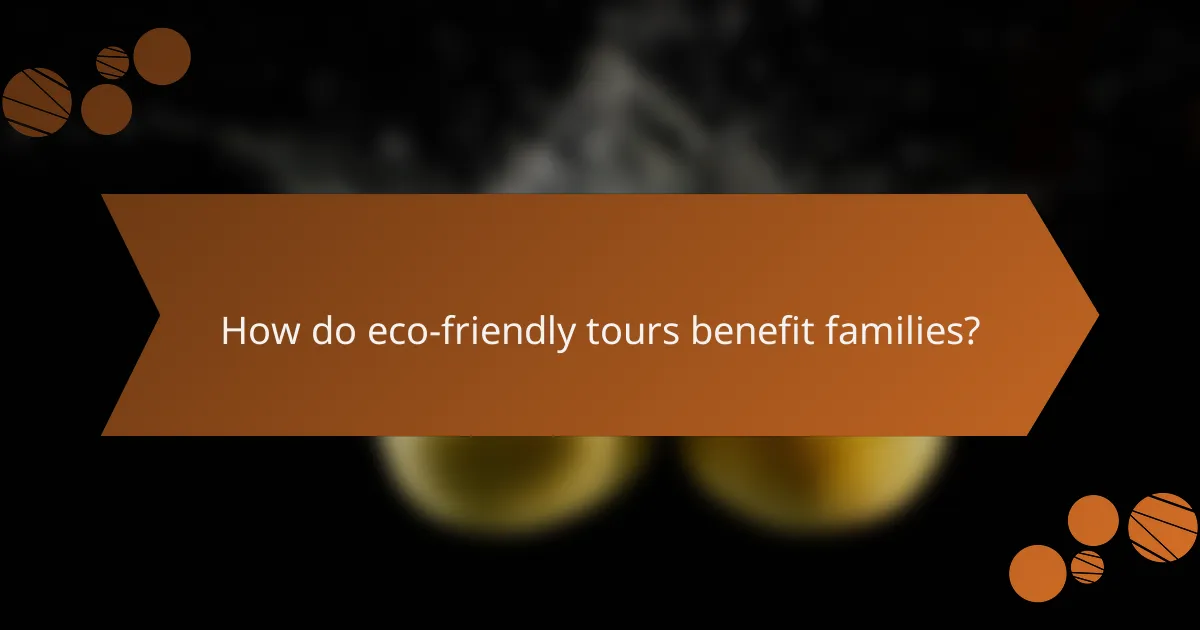
How do eco-friendly tours benefit families?
Eco-friendly tours offer families a chance to engage with nature while promoting environmental responsibility. These experiences not only enhance family bonding but also instill values of sustainability in children, making them more aware of their impact on the planet.
Encourages outdoor activities
Eco-friendly tours often take place in natural settings, encouraging families to participate in outdoor activities like hiking, kayaking, or cycling. These activities promote physical health and foster a love for nature among children.
Families can choose tours that cater to various skill levels, ensuring that everyone, from young children to adults, can enjoy the experience. Look for options that include guided nature walks or wildlife observation to enhance engagement.
Teaches sustainability practices
Participating in eco-friendly tours provides families with practical lessons in sustainability. Many tours incorporate educational components that explain the importance of conservation, recycling, and reducing waste.
Families can learn about local ecosystems and how their actions affect the environment. Consider tours that involve hands-on activities, such as planting trees or participating in beach clean-ups, to reinforce these lessons.
Provides unique learning experiences
Eco-friendly tours offer unique learning opportunities that go beyond traditional education. Families can explore diverse habitats, meet local wildlife, and understand the cultural significance of the areas they visit.
Look for tours that include expert guides who can share insights about the local flora and fauna. This immersive experience can spark curiosity and inspire children to ask questions and seek knowledge about the world around them.
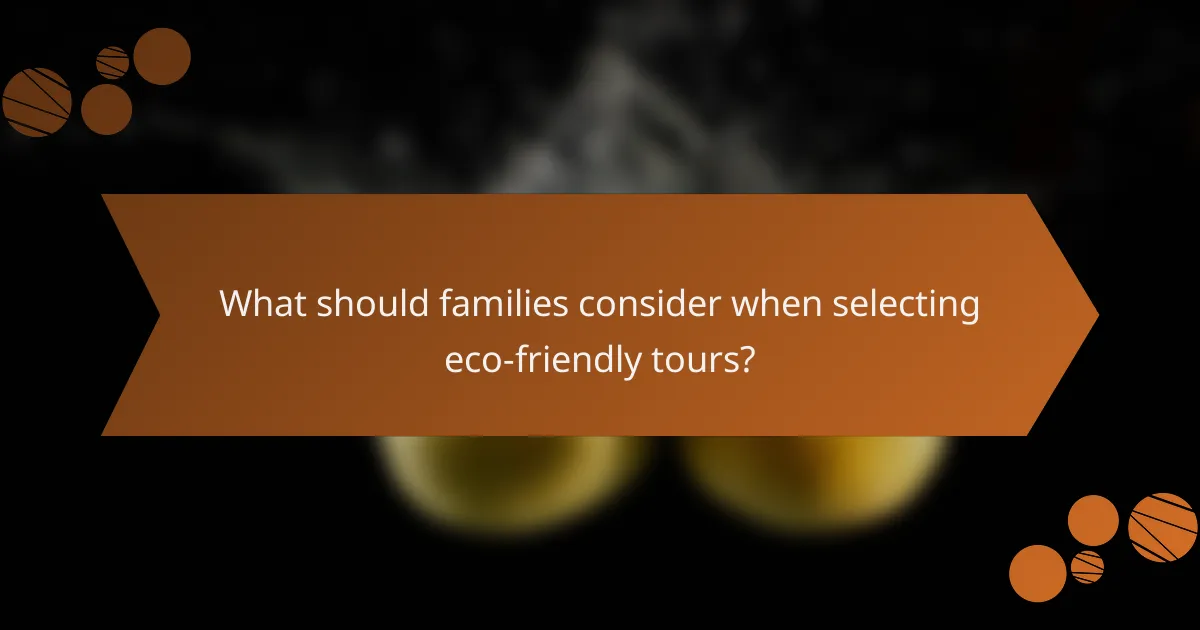
What should families consider when selecting eco-friendly tours?
Families should prioritize sustainability, safety, and personal engagement when choosing eco-friendly tours. Key factors include the tour operator’s certifications, the size of the group, and the availability of safety and accessibility features.
Tour operator certifications
When selecting an eco-friendly tour, check for certifications that indicate a commitment to sustainable practices. Look for recognized labels such as Green Globe or EarthCheck, which ensure that the operator adheres to environmental standards. These certifications can provide reassurance that the tour minimizes its ecological footprint.
Additionally, consider whether the operator participates in local conservation efforts or community projects. This involvement not only supports local economies but also enhances the educational aspect of the tour for families.
Group size and personal attention
Smaller group sizes often lead to a more personalized experience, allowing families to engage more deeply with the environment and guides. Aim for tours that limit participants to a manageable number, ideally under 15, to ensure everyone receives adequate attention and can interact meaningfully with the guide.
Personal attention can also enhance safety, as guides can monitor group dynamics and address individual needs more effectively. This is particularly important for families with children who may require additional support during activities.
Safety and accessibility features
Safety should be a top priority when selecting eco-friendly tours. Ensure the operator has clear safety protocols in place, such as first aid training for guides and well-maintained equipment. Families should inquire about emergency procedures and the availability of safety gear, especially for outdoor activities.
Accessibility is another crucial consideration. Look for tours that accommodate various mobility levels, ensuring that all family members can participate comfortably. Operators should provide options for those with disabilities, such as wheelchair access or alternative routes for challenging terrain.
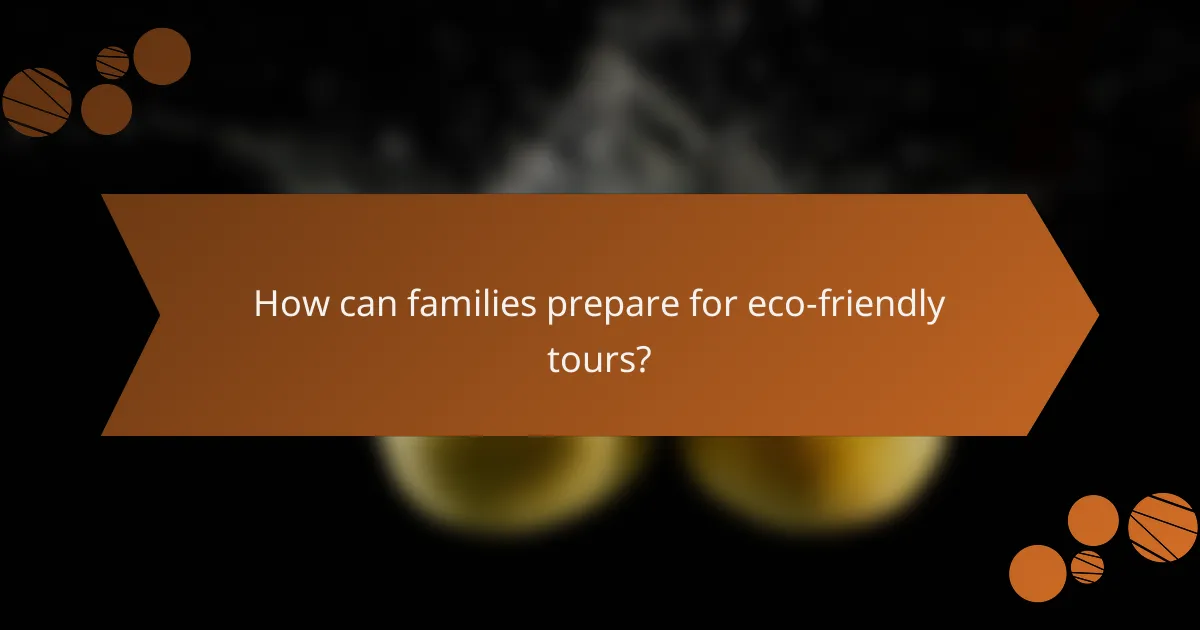
How can families prepare for eco-friendly tours?
Families can prepare for eco-friendly tours by planning ahead and considering their environmental impact. This includes choosing sustainable activities, packing responsibly, and being mindful of local ecosystems.
What to pack for the tour
When packing for an eco-friendly tour, focus on items that minimize waste and support sustainability. Bring reusable water bottles, cloth bags, and eco-friendly snacks to reduce single-use plastics.
Consider packing biodegradable toiletries and a compact first-aid kit. Lightweight clothing made from natural fibers is also a good choice, as it is often more breathable and environmentally friendly.
Understanding local wildlife
Familiarizing yourself with local wildlife is essential for an eco-friendly tour. Research the species that inhabit the area and understand their habitats to avoid disturbing them.
Teach children about the importance of wildlife conservation and the role each species plays in the ecosystem. This knowledge fosters respect and encourages responsible behavior during the outing.
Planning transportation to the tour site
Choosing the right transportation is crucial for reducing your carbon footprint. Opt for public transport, carpooling, or electric vehicles when possible to minimize emissions.
If the tour site is within walking distance, consider hiking or biking as a fun and eco-friendly alternative. Always check local regulations regarding transportation options to ensure compliance and safety.
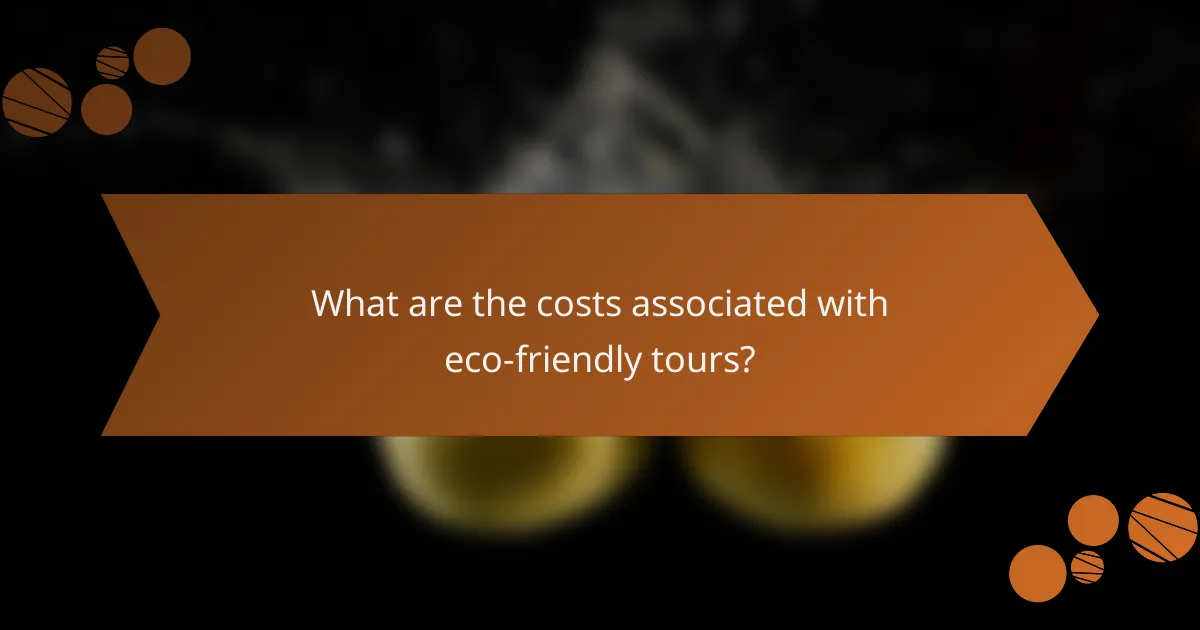
What are the costs associated with eco-friendly tours?
The costs associated with eco-friendly tours can vary widely based on factors such as location, duration, and the specific activities included. Families should expect to spend anywhere from moderate to higher amounts compared to traditional tours, but the benefits often justify the investment.
Average pricing for family tours
On average, eco-friendly family tours can range from around $50 to $200 per person for a day trip, depending on the destination and included amenities. For example, guided nature hikes or wildlife tours may fall on the lower end, while multi-day eco-lodges or specialized experiences could be at the higher end.
When budgeting, consider the total cost for the entire family, which can add up quickly. For a family of four, this could mean spending between $200 and $800 for a single outing, depending on the tour’s length and features.
Discounts for groups or families
Many eco-friendly tour operators offer discounts for larger groups or families, which can significantly reduce the overall cost. Discounts may range from 10% to 20% for groups of six or more, making it more affordable for families to participate together.
It’s advisable to inquire about any available promotions or package deals when booking. Some companies may also provide free or discounted rates for children, further enhancing the value for families.
Potential additional fees
While eco-friendly tours often include most costs in the initial pricing, families should be aware of potential additional fees. These can include transportation costs, equipment rentals, or entrance fees to protected areas, which may not be included in the base price.
Before booking, clarify what is covered in the tour price and ask about any extra charges. This will help avoid surprises and ensure that the family can fully enjoy the experience without unexpected expenses.
